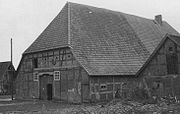
Oerbke
Encyclopedia

Lüneburg Heath
The Lüneburg Heath is a large area of heath, geest and woodland in northeastern part of the state of Lower Saxony in northern Germany. It forms part of the hinterland for the cities of Hamburg, Hanover, and Bremen and is named after the town of Lüneburg. Most of the area is a nature reserve...
in Lower Saxony
Lower Saxony
Lower Saxony is a German state situated in north-western Germany and is second in area and fourth in population among the sixteen states of Germany...
. Oerbke lies on the A7 autobahn east of Bad Fallingbostel
Bad Fallingbostel
Bad Fallingbostel is the district town of the Heidekreis district in the German state of Lower Saxony. Since 1976 the town has had a state-recognised Kneipp spa and has held the title of Bad since 5 August 2002. It has close ties to Walsrode, a few miles to the west...
and is the seat of administration for the Osterheide
Osterheide
Osterheide is an unincorporated area in the district of Heidekreis, in Lower Saxony, Germany.The area has 815 inhabitants . Its administrative seat is the village of Oerbke; other villages are Ostenholz and Wense...
area.
History
The farming village of Oerbke was first mentioned in the surviving records in 1256 and, by 1438, there were 8 farmsteads reported in the area as well as 4 individual houses (Kotstellen). The farms and houses were also evident in the registers in 1563, 1589 and 1628, so they were very long-lived here, probably due to the fertile soil. Until 1935 the village had been a purely agricultural settlement for centuries.During the Third Reich the German armed forces, the Wehrmacht
Wehrmacht
The Wehrmacht – from , to defend and , the might/power) were the unified armed forces of Nazi Germany from 1935 to 1945. It consisted of the Heer , the Kriegsmarine and the Luftwaffe .-Origin and use of the term:...
established a prisoner-of-war camp in Oerbke in which up to 30,000 soldiers from the Red Army
Red Army
The Workers' and Peasants' Red Army started out as the Soviet Union's revolutionary communist combat groups during the Russian Civil War of 1918-1922. It grew into the national army of the Soviet Union. By the 1930s the Red Army was among the largest armies in history.The "Red Army" name refers to...
were housed. After 1945 Oerbke Camp was initially used by the British Forces as a detention centre and displaced persons camp. Later the Oerbke East settlement (Ostsiedlung Oerbke) was used for troops exercising on the Bergen-Hohne Training Area
Bergen-Hohne Training Area
Bergen-Hohne Training Area is a NATO military training area in the southern part of the Lüneburg Heath, in the state of Lower Saxony in northern Germany. It covers an area of , which makes it the largest military training area in Germany.It was established by the German armed forces, the...
.
Family names
Closely linked to the history and development of the village are long-established families. The oldest family names include:- 1379: henneke hoyers, Odde, henneke luders
- 1438: Ludeke in deme Broke, Olveke, Sandman, Hermen Lange, Ghildehus, Hermen Hoyers, Eggerd in der Koten, Henneke Odden, Tideke Ebeling, Hinrik Hoyers, Henneke Luders
- 1528: Jacob im Broke, Carsten Hoyger, Roders, Olücke, Hinrick Odden, Marthinß, Laurentius, Bartolt Lüders, Peter, Hans Wobbeken
Cultural monuments

- Cemetery of the Unknown Soldiers (Friedhof der Namenlosen), a war cemetery in which about 30,000 Russian prisoners-of-war from the Second World War are buried in mass graves.

